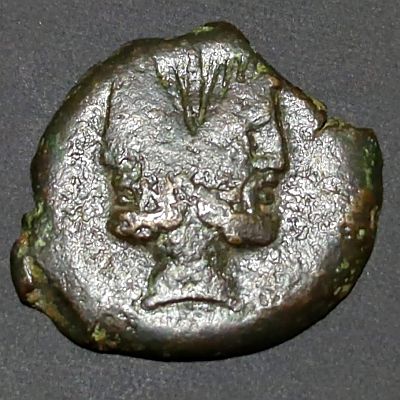Like many Roman pieces today, (or at least the ones I can afford), here is a coin which looks a bit rough, but has a lot of history. It is a later example of one of the earliest types of Roman coins. It even has a connection to Pompeii.

Although not great seafarers, Rome did feature ships on their coins. Particularly after the first Punic War, in the mid third century BC. “Aes Grave” coins are large bronze coins, common in the Roman Republic era. Mine is a later example, minted around 91 BC. They often featured a ship’s prow on one side, and Janus on the other.

Janus was the Roman God of Doors, Gates, and Transitions. Janus’ oversight included the middle ground between both concrete and abstract dualities such as life/death, beginning/end, youth/adulthood, rural/urban, war/peace, and barbarism/civilization. Typically depicted with two faces, Janus can also be found with four. As the god of transition and beginnings, the first month of the year, January, is named after Janus.
One other important and interesting thing about this coin, is its connection to Pompeii. Most of us associate Pompeii with being buried after the eruption of Mount Vesuvius in 79 AD. Prior to that event, Pompeii was a popular holiday destination for well-to-do Romans. Pompeii wasn’t a main Roman mint, so is not readily associated with coinage. There is evidence, however of a pseudomint at Pompeii. Basically, an unofficial mint, producing barbarous coins to meet local need, an interesting feature of central Italy in the late second and first centuries BC. As the eruption buried Pompeii as it was in the middle of daily life, it does give an important insight into Roman civilisation at the time. A study of around 1,000 coins found at Pompeii, has shed light on the coins used in daily transactions in the city at the time. Of the four main types so far uncovered, coins featuring Janus’ head and a ship’s prow have been among the more common finds. The image on World Archaeology is a different variant to mine, but I am happy to stretch it to a “link”. Even though in all likelihood, all it demonstrates is that these coins were common across the late republic / early empire.

According to Roman Mythology, Janus ruled over Latium (central Italy, where Rome is) during its golden age, and welcome Saturn, the God of wealth, who arrived by ship. According to Saturnalia, by 5th century philosopher, Macrobius, when Janus created the first coins he stamped his image on one side, and the prow of a ship, representative of Saturn, on the other side.
With the year starting in January in honour of Janus, and ending with the Saturnalia festival, honouring Saturn, this also led towards the idea of heads or tails (heads or ships) – tossing a coin to chance one of two outcomes.
So, my example is not the highest detail example, but still, a very historic coin.
One question remains unanswered (not counting the explanation in Saturnalia): What was the first Roman coin? Thanks to Mark on Mastodon for prompting me to look into this! From National Geographic, the Roman Republic was founded in 509 B.C. after the last Etruscan king that ruled Rome was overthrown. Coinweek have some info on Etruscan coins, and the earlier Aes Grave article I already linked to mentions Aes Rude as being the precursor to Aes Grave coins. Both types of coins were based on weight of metal. Ancient Resources and Forum Ancient Coins both have a range of pictures of these very early coins.
What was the first recognisable Roman coin? Most sources I have found continue to suggest the Aes Grave, although all start talking about coins from 200 – 300 BC. I can only assume that Aes rude continued to be used up until this point? Collecting Ancient Coins has a few pictures of specifically early Aes Grave coins from 280 – 276 BC.


Leave a Reply